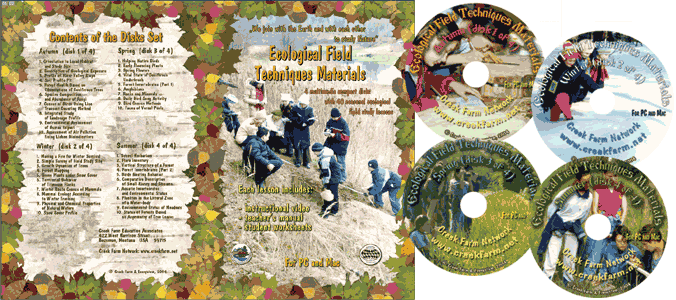|
| Our Field Ecology Center published more than
180 methodical materials for nature studies. Some of them are in English: |
|
|
|
Assessment of Environmental State of the Forest Based on LeavesТ
Asymmetry
© Alexsander S. Bogolyubov,
Russia, 2002
© Michael J. Brody, USA,
2003
 This manual contains
procedure for assessment of environmental state of the area, in particular, forests, based
on integral characteristics of asymmetry of tree leaves. The procedure is based on the
theory that difference between the left and the right halves of a leaf correlates with the
degree of total environmental disturbance. This manual contains
procedure for assessment of environmental state of the area, in particular, forests, based
on integral characteristics of asymmetry of tree leaves. The procedure is based on the
theory that difference between the left and the right halves of a leaf correlates with the
degree of total environmental disturbance.
This field study has instructional video
featuring real students conducting the ecological field techniques in nature. Each video
illustrates the primary instructional outcomes and the major steps in accomplishing the
task including reporting the results.
Introduction
The procedure used in the course of present research is based on the theory of Уdevelopment
stabilityФ (Уmorphogenetic homeostasisФ), elaborated by Russian scientists A.V.
Yablokov, V.M. Zakharov and others in the course of studies of nuclear pollution effects
after the Chernobyl disaster. Those scientists proved that stress-impact of different
types caused changes in development homeostasis (stability) of living
organisms and those changes could be evaluated on the basis of disturbance of morphogenetic
processes.
Main indicators of changes in homeostasis of morphogenetic processes are indicators of fluctuating
asymmetry Ц undirected differences between the left and right sides of different
morphological structures, which were normally bilaterally symmetrical. Such differences
are usually caused by errors in the course of organism development. Under normal
conditions, their level is minimal, but it increases at any stressing impact, which
results in increase of asymmetry.
Peculiarity of development stability is that it greatly depends on general genetic
changes in the organism and that is especially important when evaluating effects of
radiation impact.
Assessment of fluctuating asymmetry of bilateral organisms made a good showing in
determination of the total load of anthropogenic impact. Traditional methods
evaluating chemical and physical parameters do not provide integrated idea of impact upon
a biological system, whereas bioindication indexes reflect organismТs
response to the whole diversity of impact factors and they have biological meaning at the
same time.
Optimal objects for bioindication of anthropogenic impact according to the
mentioned procedure are plants. Animals, especially higher ones, are not right for such
bioindication. First of all, they are more complicatedly organized and their development
stability depends on more factors. Secondly, they are found at higher levels of pyramid of
numbers and they are less exposed to pollution of soils and air environment. Finally,
animals can move and they are less attached to a certain site.
Plants as producers in the ecosystem are attached to a local area all their life and
are exposed to influence of soil and air environments, which reflect the whole complex of
stressing impact upon the ecosystem better.
Within the framework of the given lesson, students are proposed to assess
development stability (degree of fluctuating asymmetry) on the example of leaves taken
from one of deciduous tree species found in their area. This work is not difficult in
terms of techniques and required knowledge, but it is very scrupulous. Minimum of
equipment is required for the fulfillment of the work: dividers, a ruler, protractor,
forms for measurement data recording and counting equipment ( a calculator or a computer).
General information on organization of studies
When planning the work it is necessary to bear in mind that its field part
(collection of field material) takes insignificant share of total time required for
conduction of the study. Most part of the time will be spent in the laboratory as students
will take measurements and conduct estimations. Hence, it is necessary to take it into
account while planning the total time of studies.
The matter is that any bioindication study is of scientific significance only in case
if it is carried out not in one point and at single moment of time, but it covers several
geographical points or is extended along several time periods. In other words, data of ...
This was only the first page from the manual and its full version you can see in the
Ecological Field Studies Techniques Video 4CD Set:
It is possible to purchase the complete set of 40 seasonal Ecological Field
Studies Techniques Video (in mpg format) in an attractive 4 compact disk set.
These compact disks are compatible with Mac and PC computers.
The videos are suitable for individual student or whole class instruction. To purchase the complete 4CD set
write to ecosystema1994@yandex.ru in a free form.

Ecological Field Studies Demo Disk:
We also have a free and interesting demonstration disk that explains our ecological field studies approach.
The demo disk has short excerpts from all the seasonal field study videos as well as sample text from all the teacher manuals.
The disk has an entertaining automatic walk through which describes the field study approach and explains how field studies meet education standards.
You can also download the Demo Disc from ecosystema.ru/eng/eftm/CD_Demo.iso.
This is a virtual hybrid (for PC and Mac computers) CD-ROM image (one 563 Mb file "CD_Demo.iso").
You can write this image to the CD and use it in your computer in ordinary way.
You also can use emulator software of virtual CD-ROM drive to play the disk directly from your hard disk.

|







